The British and Irish Meteorite Society (BIMS) |
Please click on the section headings below to chose the section you wish to read.
|
| About Meteorites - Introduction |
|
|
| About Meteorites - Identification |
Meteorites usually have several features which distinguish them from normal (terrestrial) Earth rocks. A particular meteorite will probably not exhibit all of these features:
- Fusion Crust - As a meteoroid passes through the atmosphere it becomes heated and the surface is melted and flows away (ablates), this process happens constantly until the rock slows down and becomes cool enough for the final melted surface to solidify. This forms a fusion crust which is usually black in colour on a freshly fallen meteorite. (Image shows a 19.7g fresh individual of Oum Dreyga, H3-5)
|  |
- Metal - The majority of meteorites contain some free metal, a mixture of iron and nickel with trace amounts of other elements. This means that they are attracted to a magnet and typically have a higher density than most terrestrial rocks. Some terrestrial rocks are attracted to a magnet, but it is very rare for iron to exist as free metal in a terrestrial rock. (Image shows a 6.2g slice of NWA 2710, H5)
|  |
- Regmaglypts - Also called thumbprints since they appear like thumb prints in modelling clay. The surface of a meteorite can show depressions. These are formed as material is ablated at varying rates during the rocks passage through the atmosphere. (Image shows a 133g individual of NWA 1685)
|  |
- Chondrules - Early in the formation of the Solar System as material began to accrete, some of the material was flash heated and melted. In it's low gravity surroundings this material formed spherical droplets which then solidified. The accretion process then continued and these small (sub millimetre to a few milimetres in size) spherical structures became incorporated into larger rocks. These structures are called chondrules and are not present in any terrestrial rocks. (Image shows a 4.4g part slice of NWA 2377, L3.7)
|  |
- Flow lines/Orientation - As material is ablated during the rocks passage through the Earth's atmosphere it can leave flow lines in the fusion crust as the molten rock flowed towards the trailing edge of the stone. If the rock wasn't tumbling as it fell it may have a clear front and rear face, with obvious flow marks from front to back, and a 'roll over lip' on the rear face. True orientation is relatively rare. (Image shows a cast of the highly oriented 1.6kg Middlesborough meteorite)
|  |
|
| About Meteorites - Classification |
|
|
| About Meteorites - Stones: Chondrites |
|
|
| About Meteorites - Stones: Achondrites |
|
|
| About Meteorites - Stony-Irons |
|
|
| About Meteorites - Irons |
|
|
| About Meteorites - Classification Continued |
|
|
| About Meteorites - Further Reading |
|
|
| Buying Meteorites |
|
|
| Found a Meteorite? |
|
|

